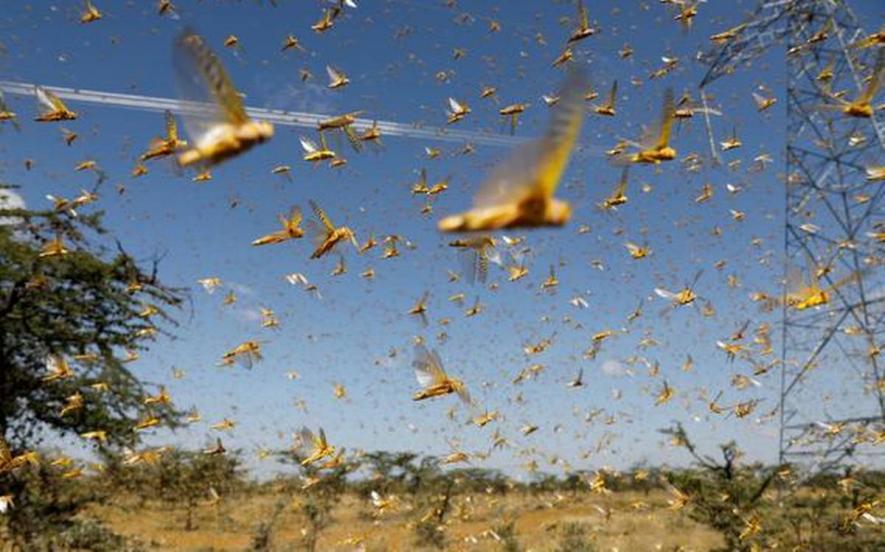Desert Locust Swarms Hit Parts of India, Another Infestation Likely in June, Says UN Official

Representational image. | Image Courtesy: The Hindu
May 22: After ravaging crops in several Indian states last year and earlier this year, desert locusts have already hit parts of India this month and another swarm is expected to enter India and Pakistan in June, a top official of the UN’s food and agricultural agency has warned.
Recent reports mention that swarms have already moved as far inland as Madhya Pradesh, with about 16 districts of Rajasthan affected so far. A report in The Times of India on Friday mentions that the district administration of Agra in Uttar Pradesh has sounded a warning as well.
The desert locust invasion, which poses a significant threat to the livelihoods and food security, is expected to move from East Africa to India and Pakistan next month and could be accompanied by other swarms. The original swarm that came up in 2019 originated in the horn of Africa and had moved eastward. The first wave of locusts had hit Rajasthan in May last year and had caused damage to crops spread over lakhs of hectares.
The desert locust is considered the most destructive migratory pest in the world and a single swarm covering one square kilometre can contain up to 80 million locusts.
The Food and Agriculture Organisation (FAO’s) Senior Locust Forecasting Officer Keith Cressman said: “Everybody knows we're facing one of the worst desert locust situations that we've probably had in a number of decades”.
“It's obviously being focused at the moment on East Africa, where it's extremely vulnerable in terms of livelihoods and food security but now in the next month or so it will expand to other areas and will move (towards)…West Africa,” Cressman added, according to PTI.
“And it will move across the Indian Ocean to India and Pakistan,” Cressman reportedly said during a virtual briefing on Thursday on the FAO Desert Locust Appeal amid the new threat to Southwest Asia and Africa’s Sahel region.
Changing weather patterns and unseasonal rainfall has been considered as a major factor in the locust swarms multiplying. The insects breed faster when aided by rainfall and the untimely rains in most parts of north India in April cannot be ruled out as a reason for their upsurge.
As of now, countries like Kenya, Somalia, Ethiopia, southern Iran and parts of Pakistan are worse off. In June, locust swarms are expected to move from Kenya to throughout Ethiopia, as well as to Sudan and perhaps West Africa.
“The infestations in southern Iran, and in southwest Pakistan, they will move to India and Pakistan on the border areas. And those infestations in India and Pakistan could be supplemented by other swarms coming from East Africa, Northern Somalia,” he Cressman is quoted saying.
Locust swarms look like clouds when they descend, and the insects can travel upto 150 kilometres a day, and consume their body-weight in food during the day. They can multiply between 16 and 20 times in three months when conditions are favourable.
Cressman said that the UN’s FAO is working with countries to upscale and intensify their monitoring and control operations. The FAO has also made an appeal to the international community for about USD 153 million to fund these increased operations.
“We're focusing on Kenya, Somalia and Ethiopia, and we have been focusing on those countries now since the beginning of the year, but the focus now will be extending to Yemen, Iran, Pakistan, and if need be to West Africa,” the official said.
The FAO's Desert Locust appeal, launched in January, now covers 10 countries – Djibouti, Eritrea, Ethiopia, Kenya, Somalia, South Sudan, Sudan, Uganda, Tanzania and Yemen.
The current upsurge is particularly alarming in the broader Eastern Africa region, with recently released forecasts from the Global Report on Food Crises indicating that over 25 million people will face acute food insecurity in the region in the second half of 2020.
In Yemen, where locusts have been reproducing in hard-to-access inland areas, an additional 17 million people are acutely food insecure.
But those estimates were made before the impact of COVID-19 in a region of acute food insecurity.
India has proposed to Pakistan and Iran for a coordinated approach in dealing with the alarming threat of fast-increasing desert locusts in the region, official sources told PTI on Thursday. However, Pakistan is yet to respond to India's proposal while Iran communicated its readiness for a joint approach to contain the desert locusts.
Officials in Jaipur said this week that locust outbreaks may affect more Rajasthan districts adjoining Pakistan this year as compared to the previous one.
The Rajasthan government has made an emergency plan to deal with the infestation and preparations are being made to spray insecticides from drones in remote inaccessible areas for effective control measures, they said.
State Agriculture Minister Lalchand Kataria on Monday reviewed locust control, kharif procurement process and Prime Minister's Crop Insurance Scheme with officials, according to the news agency.
Get the latest reports & analysis with people's perspective on Protests, movements & deep analytical videos, discussions of the current affairs in your Telegram app. Subscribe to NewsClick's Telegram channel & get Real-Time updates on stories, as they get published on our website.
























